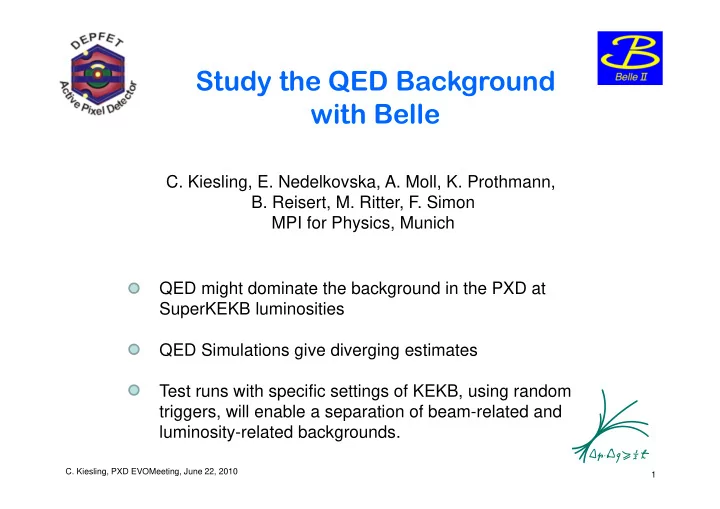

Study the QED Background with Belle C. Kiesling, E. Nedelkovska, A. Moll, K. Prothmann, B. Reisert, M. Ritter, F. Simon MPI for Physics, Munich QED might dominate the background in the PXD at SuperKEKB luminosities QED Simulations give diverging estimates Test runs with specific settings of KEKB, using random triggers, will enable a separation of beam-related and luminosity-related backgrounds. C. Kiesling, PXD EVOMeeting, June 22, 2010 1
Status of QED Simulations SuperB QED simulations (Frascati workshop): 10MHz/cm 2 they use the BDK generator (as we do also) yields 1.5 % occupancy for PXD (inner layer) this is dangerously close to the „limit“ of 2 %! Set of MCs studied: KoralW gives result inconsistent with SuperB simulations ( ~ order of magnitude smaller! Now: only 4 times bigger) Conclusion: do beam tests to find the correct answer C. Kiesling, PXD EVOMeeting, June 22, 2010 2
QED Processes at SuperKEKB (Belle II) Cross sections for s-channel processes fall like 1/s Rate ~ 600 ev/s @10 3 / nb s Cross sections for t-channel processes are largely independent of s + - e e : s ~ 50 nb 7 s ~ O (10 nb) Bhabha scattering 2-photon-processes C. Kiesling, PXD EVOMeeting, June 22, 2010 3
QED Processes of Importance 2-photon processes dominate by far Several generators: Diag36 (Berends-Daverfeldt-Kleiss, 1985) called BDK Grace (J.Fujimoto, et.al. Comp.. Phys. Comm. 100 (1997) 128) Racoon (A.Denner, S.Dittmaier, M.Roth, D.Wackeroth, Comp. Phys. Comm.. 153 (2003) 462) KoralW (S. Jadach, W. Placzek, M. Skrzypek, B.F.L. Ward, CERN-TH/95-205, Jul 1995, CPC 94 (1996) 216 … ) all done for symmetric e+e- machines (PETRA, LEP), all tested there! C. Kiesling, PXD EVOMeeting, June 22, 2010 4
QED spectrum: KW and BDK PT th cut Lab Energy lower part PT th cut Lab Energy lower part Electron PT th cut Lab Energy lower part Electron Entries Entries 792 792 Mean Mean 0.017 0.017 RMS RMS 0.01221 0.01221 60 KW 50 BDK 40 30 Spectrum normalized to one event 20 10 0 0 0.01 0.02 0.03 0.04 0.05 0.06 0.07 0.08 0.09 0.1 GeV C. Kiesling, PXD EVOMeeting, June 22, 2010 5
„Measurement“ of QED Hit multiplicity in the SVD per randomly triggered event Hits are generated by 3 sources: B-Physics (very few) Machine background QED Task: try to separate the three sources by measuring <hit/event> as function of L C. Kiesling, PXD EVOMeeting, June 22, 2010 6
Simple-Minded Analysis <hits/event> Measure R=<hits/event> as function of luminosity (given by Bhabha events) R Extrapolate to L=0 to get „non-QED“ background Difference = QED rate Background Vary the luminosity in different ways to control the systematics. L C. Kiesling, PXD EVOMeeting, June 22, 2010 7
Proposal for Random Trigger Runs Get rid of „physics“: use random triggers Assumption: The „non-physics“ hits in the SVD are generated by: beam background (roughly proportional to beam current ?) QED processes (proportional to luminosity) Idea: try to separate the two components and thus determine the QED cross section „simple“ solution: run with colliding and sepatated beams colliding: beam-gas + QED ( Exp. A) separated: only beam-gas C. Kiesling, PXD EVOMeeting, June 22, 2010 8
Proposal for Random Trigger Runs (cont.) Cross check of the beam separation method: colliding beam runs with changing transverse size of beam spot ( Exp. B ) changing beam currents (beam optics unchanged) ( Exp. C ) For each of the 3 experiments we propose a set of several runs with a total of 200 k – 400 k random triggers and 50 k Bhabha (lumi) triggers. The number of events is determined by requiring a <1% accuracy for the average number of hits in each of the four SVD layers (for Exp. A there are no Bhabha events. Still the Bhabha trigger should be enabled during all time) C. Kiesling, PXD EVOMeeting, June 22, 2010 9
Runs on May 28, 2010 Random trigger rate: 400 Hz Bhabha trigger rate: 50 Hz (adjust prescale at nominal, but moderate luminosity) run with <=10 /nb s Run unit: 400 k triggers at 400 Hz = 30 min (including beam setup) vary luminosity in steps of 2/nb s 10, 8, 6, 4 /nb s about 400 k triggers per run Together with setup for triggers / beams: 17 hours (8:00 – 1:00 (Saturday) C. Kiesling, PXD EVOMeeting, June 22, 2010 10
11 C. Kiesling, PXD EVOMeeting, June 22, 2010
12 C. Kiesling, PXD EVOMeeting, June 22, 2010
Analysis Strategies Background is NOT independent of luminosity (in all exps.) More refined strategies necessary to limit QED (up to now we cannot exclude the new SuperB number 2.5 MHz/cm 2 ) Observation: CDC varies with L This means: there is lumi-related BG other than 2 photon QED Variation of lumi.related bg can be added as background take slope from CDC current variation to „flatten“ the background C. Kiesling, PXD EVOMeeting, June 22, 2010 13
Summary & Conclusions Three experiments proposed (A, B, C) , data were taken Total of 2 full shifts + were needed (Friday, May 28, starting at (8:00 – Satursay 1:00) New setup for random trigger in Belle was OK Data taking was mostly smooth (beams lost at small luminosities Background variation much more complicated than anticipated Analysis is going on and will hopefully lead to confirmation of KoralW Runs were taken recently with machine off (0 lumi) also: Experiments likely to be repeated with a lower field in Belle, e.g. 1T C. Kiesling, PXD EVOMeeting, June 22, 2010 14
Recommend
More recommend